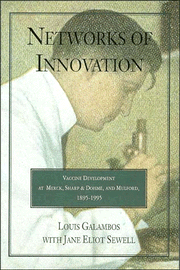Book contents
- Frontmatter
- Contents
- PREFACE
- 1 1894: “The foremost medical question of the day”
- 2 The Mulford Story
- 3 A Sharp & Dohme Interlude
- 4 The Virology Network and a New Program at Merck Sharp & Dohme
- 5 Hilleman's Innovations: First Phase
- 6 Dangerous Interlude
- 7 Transforming Bacteriology: A Second Phase
- 8 New Networks, New Leadership: The Hepatitis B Vaccines
- 9 Vaccine Innovation in the Nineties: New Strategies, New Opportunities, and Public Confrontations
- 10 Historical Perspectives on the Process of Innovation
- ACKNOWLEDGMENTS
- A WORD ABOUT SOURCES
- INDEX
- Plate section
9 - Vaccine Innovation in the Nineties: New Strategies, New Opportunities, and Public Confrontations
Published online by Cambridge University Press: 06 July 2010
- Frontmatter
- Contents
- PREFACE
- 1 1894: “The foremost medical question of the day”
- 2 The Mulford Story
- 3 A Sharp & Dohme Interlude
- 4 The Virology Network and a New Program at Merck Sharp & Dohme
- 5 Hilleman's Innovations: First Phase
- 6 Dangerous Interlude
- 7 Transforming Bacteriology: A Second Phase
- 8 New Networks, New Leadership: The Hepatitis B Vaccines
- 9 Vaccine Innovation in the Nineties: New Strategies, New Opportunities, and Public Confrontations
- 10 Historical Perspectives on the Process of Innovation
- ACKNOWLEDGMENTS
- A WORD ABOUT SOURCES
- INDEX
- Plate section
Summary
THE RECOMBINANT DNA technology and the rapidly developing knowledge of gene activity in viral and bacterial pathogens created intriguing opportunities for vaccine innovation in the early 1990s. In its early phase – and it is still in that stage – this particular science/technology cycle resembled in certain regards the bacteriological revolution of the late nineteenth century – the cycle of innovation that yielded the first serum antitoxins and persuaded the H. K. Mulford Company to venture into the new field of biologicals. During the early phase of both cycles, the opportunities for new therapies seemed boundless, giving rise to numerous, small entrepreneurial companies. In both, there were powerful institutional and social barriers to the successful introduction of innovative biological products. In both, the politics of immunization at times overshadowed both the science and the enterprise of vaccines
Of course much had also changed since the 1890s, and we have traced many of those transitions in the previous chapters. By the 1990s, the sciences and technologies were far more complex and were fragmented into a much larger number of subdisciplines. Each subdiscipline had its own body of knowledge, channels of communication, leaders, techniques, and values – that is, its own network. The role of the public sector had changed decisively as well. Governmental and intergovernmental agencies were now formidable participants in vaccine distribution, and in the industry's largest markets, national governments were involved in every aspect of vaccine discovery, testing, manufacturing, and marketing.
In the United States in the post-World War II era, a highly productive mixed system had taken shape.
- Type
- Chapter
- Information
- Networks of InnovationVaccine Development at Merck, Sharp and Dohme, and Mulford, 1895–1995, pp. 211 - 240Publisher: Cambridge University PressPrint publication year: 1996



